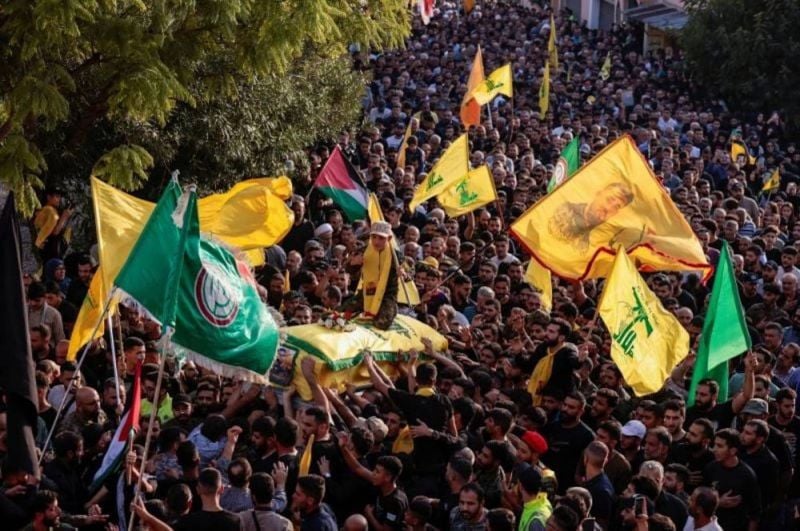
The funeral of a Hezbollah fighter recently killed near the southern border, Oct. 23, 2023. (Credit: Zohra Bensemra/Reuters)
Last Wednesday, the Jamaa Islamiya, a Sunni Lebanese party with close ties to the Muslim Brotherhood, officially announced its involvement in firing a missile at Israel. Soon afterward, the “Resistance Brigades,” a Hezbollah-founded Sunni movement, also made its presence known on the front line.
Two members of the Brigades, Hussein Hassan Abdel Aal and Ali Kamal Abdel Aal, were killed in the town Mazraat Halta Monday while attempting to recover the bodies of three Hezbollah fighters who had died during an nearby operation the day before.
This incident raises the question: Who are the “Resistance Brigades,” and what is their mission? L’Orient-Le Jour looks for the answers.
Established in 1997, just a year after Israel’s “Grapes of Wrath” operation aimed at curbing Hezbollah’s activities, the movement’s primary purpose was to bolster the “resistance.”
The group was formed immediately after the death of Hadi Nasrallah, one of Hezbollah leader Hassan Nasrallah’s sons, who was killed in an Israeli ambush in southern Lebanon during the night of Sept. 12-13, 1997. At that time, the group recruited several thousand young individuals deeply affected by the loss of Narallah’s son.
Primarily composed of Sunnis, with a few Christians and Druze who eventually withdrew, the “Resistance Brigades” were established to counter Sunni extremism that opposed Hezbollah, especially in areas where it had gained influence. This movement also sought to debunk the notion that Hezbollah was an exclusively Shiite organization. The party sought to demonstrate that the “resistance,” though primarily associated with the Shiite community, transcended sectarian boundaries.
Based in major cities and Sunni communities like Tripoli, Saida, the Bekaa and certain border areas with Israel, such as Shebaa — where a trusted local source says there are approximately 150 members — the brigades have evolved into a private militia primarily safeguarding the interests of its members.
“The organization was largely composed of individuals with criminal backgrounds, at times affiliated with local tribes,” claimed Ahmad al-Ayoubi, an expert on Islamist movements and a staunch critic of Hezbollah.
In Tripoli, it was the Sunni al-Tawhid movement, close to Hezbollah and Syria — not to be confused with the al-Tawhid al-Arabi movement chaired by Wiam Wahhab — that provided the group’s main manpower through the party’s military leader, Moaz Shaabane (the brother of al-Tawhid leader Bilal Chaabane).
Over the years, the brigades gained notoriety for various abuses committed in their areas, leading to ongoing tension with local populations.
There have even been allegations of involvement in drug and arms cartels, with their influence and authority largely derived from Hezbollah, which, at one point, provided them with political protection.
Restructuring
Although initially recruited for armed conflict, particularly against Israel, these groups rarely engaged in such activities. This raised questions about the legitimacy of their existence, as their weapons were often used at home.
Some circles critical of Hezbollah claim that these groups participated alongside Hezbollah in violent attacks in Beirut in May 2008 and again during the Syrian conflict that began in 2011. L’Orient-Le Jour has been unable to independently verify these claims.
After 2009, numerous voices arose to condemn the Brigades’ actions. Then-Interior Minister Nouhad Machnouk initiated a dialogue between representatives of the Future Movement and Hezbollah in an attempt to find a viable solution to the issue.
“More than 43 meetings were convened to establish a modus vivendi, if not a complete disarmament,”explained Kassem Kassir, an analyst closely associated with Hezbollah.
According to an anonymous source familiar with the content of these meetings, a security plan was put in place in all the areas where the Brigades were operating to curb the movement.
“The plan was applied just about everywhere, with the exception of the Bekaa, where Hezbollah managed to thwart it,” the source asserted.
It was not until the summer of 2023 that Hezbollah decided to restore order to the movement, as criticism and complaints against it grew.
“Since then, Hezbollah has carried out a thorough restructuring and overhaul of the movement’s functions,” Kassir said.
The Brigades former senior leaders have been replaced by “more competent and educated personalities from the various areas,” Kassir said. “Members have also been trained for resistance operations when necessary.”
Hezbollah has presumably begun to take advantage of this training on the front, although the extent of its involvement remains unknown for the time being.
This story first ran in French, translated by Sahar Ghoussoub.